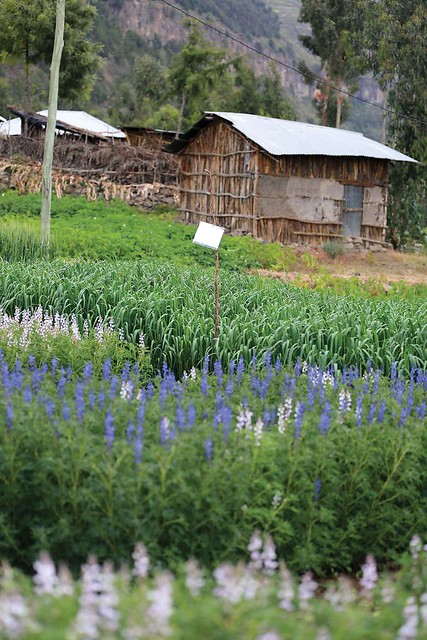
The highly nutritious Brachiaria grass (situated in the centre of the photo) thrives all year round, providing a constant supply of animal feed. Ethiopia (photo credit: ILRI/Apollo Habtamu)
The experience of the International Livestock Research Institute (ILRI) and partner scientists in 2015–2016 shows the positive benefits of implementing pioneering research and development interventions that increase the overall quantity and nutritional quality of feed biomass and help smooth seasonal feed variability, creating sustainable livelihood opportunities for smallholder livestock keepers. But the real scope for spreading the knowledge in this research lies in the development of on- and off-line tools that can be used by isolated smallholder farmers to access approaches for assessing feed constraints and developing effective feed and forage improvement interventions.
These are the findings from the feeds and forages research and interventions, presented in the ILRI Corporate report 2015–2016: highlights on livestock feeds and forages. These findings are presented in line with the three objectives set out in the ILRI strategy 2013–2022:
- Develop, test, adapt and promote science-based practices that—being sustainable and scalable—achieve better lives through livestock.
- Provide compelling scientific evidence in ways that persuade decision-makers—from farms to boardrooms and parliaments—that smarter policies and bigger livestock investments can deliver significant socio-economic, health and environmental dividends to both poor nations and households.
- Increase capacity among ILRI’s key stakeholders and the institute itself so that they can make better use of livestock science and investments for better lives through livestock.
Science into practice
Environmental constraints and market opportunities continue to drive the use of crop residues as sources of animal feed which do not require the exclusive allocation of land and water. Research by ILRI, partner CGIAR and national scientists in India has produced the first predictive model based on the association of DNA information in maize with high fodder quality traits and grain yields. This enables rapid and inexpensive selection of improved maize varieties with both higher grain yields and enhancements in biomass quality for fodder, and offers the possibility of expanding this work to climate-tolerant maize in the future.
Evidence-based decision-making
Between 2014 and 2016, more than 25,000 crop-livestock farmers in 30 districts in Ethiopia adopted legume production technologies designed to close yield gaps and prevent soil nutrition depletion; this number is expected to rise to more than 60,000 by 2018. The consequent enhancement of biomass (for feed) and grain (for food) yields, in addition to improvement in nutrition quality, have contributed to higher household incomes. Sample analysis found that more than 80% of smallholder farmers applying these technologies to chickpea cultivation increased their grain and biomass yields, as well as the nutrition content of the crop. The business-led approach has helped ensure effective and efficient supply of inputs (such as improved seeds and bio-fertilizers), the transfer of knowledge and technology, and better access to feed markets.
Capacity development
The ILRI Feed Assessment Tool (FEAST) has enabled development agents and smallholder farmers to make better use of naturally available feed resources. Responding to growing demand, a FEAST e-learning course was produced in 2015. It includes lessons on engaging rural communities, and analysing and overcoming feed constraints. Demand for the tool has risen steeply across Africa and Asia with nearly 250 users of the new tool in the first year; most of whom participate in a combination of on- and off-line blended training.
Download the highlights chapter or the full ILRI Corporate report 2015–2016
Reblogged this on Sril Group Ltd, Nigeria.